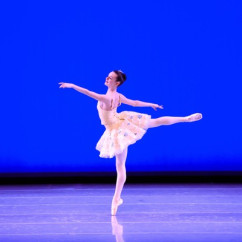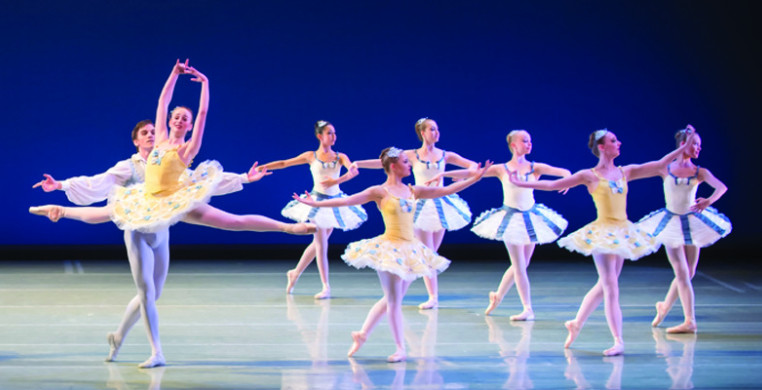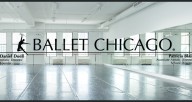UPDATE: The new seechicagodance.com will launch March 31st. Click here to learn more.
Ballet Chicago’s “Mozart and More” And All That Jazz!
Ballet Chicago’s 2024 spring concert series, “Mozart and More,” delighted audiences in two performances on May 4th at Chicago’s Harris Theater.
Under the artistic direction of Daniel Duell and associate artistic director Patricia Blair, Ballet Chicago continues to project a beacon of choreographic creativity inspired by George Balanchine’s School of American Ballet and his revolutionary choreography for the New York City Ballet.
“Mozart and More” was judiciously divided into three acts, the first featuring dancers from the Student Division as young as eight, and on up through teens. Acts two and three showcased Ballet Chicago’s impressive studio company, a polished ensemble of dancers in their teens and early twenties on the cusp of professional careers. (Side note: some of NYC Ballet’s most illustrious stars in Mr. B’s first company, such as Violette Verdi, Suzanne Farrell, Allegra Kent, and Melissa Hayden, began dancing in his professional company as young as 14.)
The entire program featured choreography that reflected Balanchine’s influence and demonstrated technical precision and artistic nuance one would not expect from a “studio” company, much less from student dancers.
In Act One, devoted to the Student Division of Ballet Chicago, company soloists, along with guest artist Ahmad Hill, anchored resident choreographer Ted Seymour’s “Secrets du Printemps" (2016), set to Maurice Ravel’s "Le Tombeau de Couperin." The sunny program opener presented a rainbow of some 32 student dancers of all shapes and sizes, but uniform in their focus, musicality, phrasing, port de bras, and lyricism.
In Patricia Blair’s “A Little Mozart” (premiere), Mozart (pianist Jeremy Harris) at the on-stage piano, introduced his frolicsome variations based on the sixteenth-century French children’s song, "Ah, vous dirai-je, Maman," better known to us as “Twinkle Twinkle Little Star.” Blair’s dramatic construct of an onstage ballet school deftly gave the student cast increasingly challenging variations to demonstrate their technical achievements, at the same time, giving the audience a perspective on the roughly ten years of training it takes to make a dancer.
From the tiniest juniors demonstrating basic arm and leg positions, pliés, and battements, to the Studio Company soloists executing sophisticated partnering and technical virtuosity, the attention to detail and artistic expression was testimony to Ballet Chicago’s aesthetic.
 "Divertimento No. 15." Choreography by George Balanchine © The George Balanchine Trust | Photograph by Maya Dion Davis (D. Davis Photography).
"Divertimento No. 15." Choreography by George Balanchine © The George Balanchine Trust | Photograph by Maya Dion Davis (D. Davis Photography).
Seymour’s premiere, “Reminiscions,” set to Mozart’s “Quintet in A Major for Clarinet and Strings,” gave seven ladies their moment in the sun. Seymour costumed his dancers in black unitards and white practice skirts, reminiscent of Balanchine’s predilection for the simplicity of practice clothes to best highlight the movement. Seymour’s attention to the inter-relatedness of music, movement gesture, and spatial design is also a hallmark of Balanchine choreography.
The piece unfolded in a lyrical cascade of musical canons, the movement and music mirroring each other. The dancers’ mutual awareness and sensitivity to each other created a pleasing dramatic through-line of camaraderie and mutual affection to an essentially abstract ballet. This doesn’t happen by accident, but rather, develops in an atmosphere of nurturing discipline that Duell, Blair, and Seymour foster as directors and teachers.
Act Two transitioned from the school to the company with Balanchine’s “Divertimento Number 15” (1956). In 2011, Ballet Chicago acquired permission from the Balanchine Trust to perform the piece. While emulating the Russian Imperial Ballet’s lavish style, and costuming the piece in Karinska’s classical tu-tu’s, this plotless ballet united the great Russian choreographer Marius Petipa’s classicism with Balanchine’s innovations.
Ballet Chicago dispatched Balanchine’s devilishly difficult variations with seeming ease, charm, and an infectious enthusiasm that filled the stage with pure joy. Of special note was the impressive battérie of the three gentlemen, Andrew Poston, Ahmad Hill, and Nikyle Scott.
Sophia Asta, Leighton Baumgartner, Blair Mendes, Caroline Stoughton, and Emma Wittig dazzled with intricate footwork, emboiteé turns, and stunning leaps, embroidering the movement with Balanchine’s turned in knees, and flexed wrists and ankles, all with a devil-may-care insouciance that defied the technical difficulty of the choreography.
Ahmad Hill’s solo was a tour de force, performed to needle-sharp perfection, his clarity and élan filling the stage with true brilliance. Watch for great things from this young man.
The round robin of stunning pas de deux partnered the three men with five ladies: Sophia Asta, Leighton Baumgartner, Blair Mendes, Caroline Stoughton, and Emma Wittig. These couples attested to a professionalism and technical virtuosity that would have been at home on any major ballet stage, each variation lush and flowing one into the next.
Duell’s revival, “Ellington Suite” (2000) closed the program, tearing up the rug with a rousing homage to 40’s jazz dance. After the initial body shock of transitioning from the upper body carriage and elegance of ballet, the dancers relocated themselves in the earthiness of jazz dance, and things really got going. Especially infectious were the men’s trio, “Hat’s Off,” Wittig and Hill’s “Delta Duet,” and the full company finale, which had the audience fairly jumping out of their seats. Bravo to Ballet Chicago for a spring season filled with exciting new work. Wouldn’t it be fun to see more?
For more information on Ballet Chicago, click the company link below.


